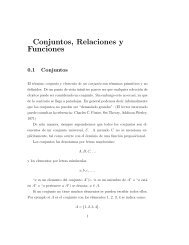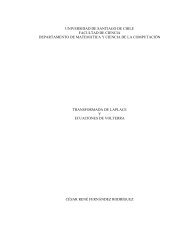Apuntes de Variable Compleja - Carlos Lizama homepage ...
Apuntes de Variable Compleja - Carlos Lizama homepage ...
Apuntes de Variable Compleja - Carlos Lizama homepage ...
Create successful ePaper yourself
Turn your PDF publications into a flip-book with our unique Google optimized e-Paper software.
46 CAPÍTULO 5. POLOS Y RESIDUOS<br />
La fórmula anterior expresa que el valor <strong>de</strong> una función analítica en un punto<br />
interior <strong>de</strong> un disco es igual al promedio pon<strong>de</strong>rado (por un peso) <strong>de</strong> un valor en<br />
el bor<strong>de</strong>. El peso en cuestion es el núcleo <strong>de</strong> Poisson.<br />
Tomando f(z) = 1 para todo z obtenemos lo siguiente<br />
Corolario 80<br />
2π<br />
1<br />
Pr(t − θ)dt = 1<br />
2π 0<br />
Una aplicación <strong>de</strong> la fórmula <strong>de</strong> Poisson es que po<strong>de</strong>mos resolver el problema<br />
siguente<br />
Problema <strong>de</strong> Dirichlet:<br />
Resolver<br />
∆u(x, y) = 0<br />
en x 2 + y 2 < 1, con condiciones <strong>de</strong> bor<strong>de</strong> dadas por<br />
para x 2 + y 2 = 1, don<strong>de</strong> g es continua.<br />
u(x, y) = g(x, y)<br />
La respuesta a este problema es (en coor<strong>de</strong>nadas polares)<br />
con 0 ≤ r < 1.<br />
u(re iθ ) = 1<br />
2π<br />
2π<br />
0<br />
Pr(θ − t)g(e it )dt<br />
Demostración. Primero veremos que u es la parte real <strong>de</strong> una función analítica.<br />
Luego, ∆u = 0 según sabemos.<br />
En efecto, sea<br />
don<strong>de</strong> γ(t) = e it .<br />
f(z) = 1<br />
2π<br />
2π<br />
= 1<br />
2πi<br />
= 1<br />
2πi<br />
= 1<br />
2πi<br />
0<br />
<br />
<br />
<br />
γ<br />
γ<br />
γ<br />
e it + z<br />
e it − z g(eit )dt<br />
w + z<br />
w − z g(w)dw<br />
Luego f(z) es analítica en |z| < 1, a<strong>de</strong>más<br />
Ref(z) = 1<br />
2π<br />
( w 1<br />
−<br />
w − z w )g(w)dw<br />
2g(w) 1<br />
dw −<br />
w − z 2πi<br />
2π<br />
0<br />
<br />
γ<br />
g(w)<br />
w dw<br />
Re( eit + z<br />
e it − z )g(eit )dt







